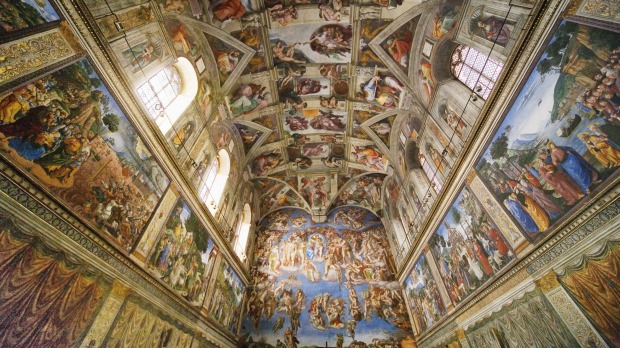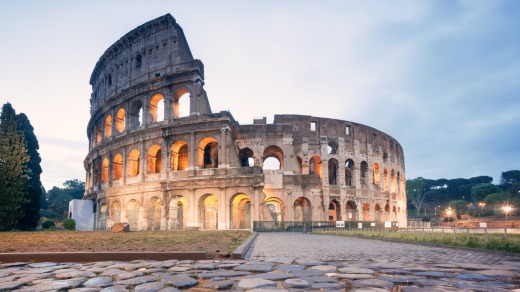
Rome is a living, breathing museum, an archaeological archive of Western culture. As you walk the city's cobblestone streets and past its omnipresent ruins, you are stepping over and through centuries of history.
You don't need to enter a museum, church or archaeological site to get a real sense of this history but specialised tours can help you delve deeper.
Go underground to explore the city's many layers. Climb high to gain a unique perspective on its ruins. Discover lesser-known aspects of the city's culture through its food. Contemplate priceless treasures while avoiding the crowds. And learn about the turbulent life of an artist whose groundbreaking style influenced generations to follow.

Here are five of Rome's best tours.
UNDER THE COLOSSEUM
The Colosseum is Rome's best-known tourist site, visited by 5 million people a year. Of those visitors relatively few get to explore the hypogeum beneath the main floor, where most of the action happened – wild beasts including lions and elephants were caged and gladiators waited to take to the stage and fight to the death – and where remains the best archaeological evidence of complex engineering structures such as elevators, cages, winches and trapdoors.
This tour, for a maximum of seven people, is part of a five-hour group tour that also takes in the ruins of the Roman Forum and Palatine Hill (but importantly avoids lengthy queues). Guides are often archaeologists, and speak perfect English. It's not for the faint-hearted or weak of leg (and the whole thing would be too much for most children). You pass through a locked gate and onto the reconstructed arena where gladiatorial combat took place, before descending to the hypogeum via stone steps and reconstructed boardwalks. It's a darker world, literally and metaphorically. In the days of the gladiators the hypogeum would have been dimly lit by oil lamps, covered in blood from slain animals and men, with a stench of death.
From the subterranean world you ascend to the gods, the top tier of the Colosseum – also off limits to the public – which gives you a unique perspective of the stadium plus unparalleled vistas of the Roman Forum and Palatine.
Underground Colosseum (plus Third Tier), Roman Forum and Palatine Hill, Through Eternity Tours, througheternity.com $158 per person.
EXCAVATIONS BEANEATH ST PETER'S
St Peter's Basilica may be a Renaissance masterpiece built during 150 years from the early 16th century but its history runs longer and deeper. The excavations beneath St Peter's begun in 1940 have uncovered part of the original church, an early Christian cemetery and Roman tombs. Archaeologists believe they have also found the tomb of St Peter. The site of the empty tomb is marked by a shrine and a wall plastered in red. Nearby is another wall scrawled with the graffiti of pilgrims. In 1942, the bones of an elderly, strongly built man were found in a box placed in a niche behind this wall. In 1976, after years of forensic examination, Pope Paul VI declared them to be the bones of St Peter.
This is an extraordinary experience, especially for people who understand and respect the history of Christianity. The sense of anticipation builds as you get deeper into the bowels of this edifice. At times you walk through low narrow passages; anyone suffering claustrophobia need not apply.
Only 250 people are allowed to visit the excavations each day and with tours conducted in various languages numbers are limited. Booking a place on one of these tours can be tricky – you need to provide information exactly as it is prescribed – and it's advisable to get organised months in advance of your visit.
Vatican Excavations Office. $17.45. Minimum age 15. See vatican.va/roman_curia/institutions_connected/uffscavi/
IN THE STEPS OF CARAVAGGIO
Michelangelo Merisi da Caravaggio (1571-1610) is one of the most fascinating artistic figures in Rome's history. Trouble with the law was a fact of life for the painter who arrived in the city about 1590 and fled it 16 years later after killing a man. His paintings were as controversial as his behaviour. His use of chiaroscuro (dramatic contrast between light and shade) influenced generations of painters, and by using peasants and prostitutes as models he gave the religious figures in his paintings an extraordinary realism that shocked the establishment. On several occasions he had to repaint commissions for churches because the subjects were deemed to be too lifelike: saints would not have had such dirty feet.
This four-hour tour explores Caravaggio's dramatic life of violence and intrigue through the prism of the artistic legacy that he left to the Eternal City. Not only do you visit churches and museums housing several extraordinary works, you also walk the streets he walked, see the church where he worshipped and the building that housed his studio (whose roof had to be removed to move the largest paintings out). For anyone with more than a passing interest in art history, this is one of the best specialised tours you can hope to do.
In the Steps of Caravaggio, Through Eternity Tours, througheternity.com $457 for a private group.
FOOD TOUR: ROMAN JEWISH CUISINE
US-raised, Rome-based food and drinks educator, author, art historian and blogger Katie Parla really knows her way around the city. She offers a number of private tours, including several that focus on art and archaeology. But it's her food tours that are especially and deservedly popular. These are available by area – with three separate tours covering the historic centre, Testaccio and the Prati-Trionfale area (near the Vatican) respectively – as well as thematic tours. Parla's La Cucina Ebraica tour delves into the history and development of Rome's Jewish food traditions. Roman Jews are the oldest Jewish community in the world outside Israel, and Roman Jewish cuisine is a product of the community's forced isolation in a gated ghetto for 300 years. The tour explores 22 centuries of culinary evolution through visits to kosher bakeries and restaurants in the Jewish Ghetto. In season the carciofi alla giudia is a must-try dish.
Roman Jewish Cuisine, Katie Parla Tours katieparla.com/tours $457 per group, three hours.
VATICAN MUSEUMS AFTER HOURS
The Vatican Museums attract superlative descriptors – phenomenal, mind blowing, and awe inspiring to name a few – and all are deserved. The Sistine Chapel, decorated by Michelangelo's frescoes, is of course the jewel in the Vatican Museums' crown. But the rest of the world thinks so too, and coping with the massive crowds can be completely overwhelming. The solution – a private group tour before the museums open or after they've closed – doesn't come cheap. You're paying for the rare privilege of having the Sistine Chapel virtually to yourself. It's bucket-list stuff.
Morning tours starting just after 7 o'clock usually last four hours, and will speed you directly to the Sistine Chapel after which you'll explore the rest of the extensive galleries at a more leisurely pace (but with the crowds). Evening tours are usually limited to two and a half hours and not all galleries are open.
Early Bird Special Vatican Tours, Rome 4 Kids Family Tours rome4kidstours.com $116/$58 adults/children plus $436 for guide.
Vatican After Hours, Context Travel contexttravel.com $4797 for up to six people.